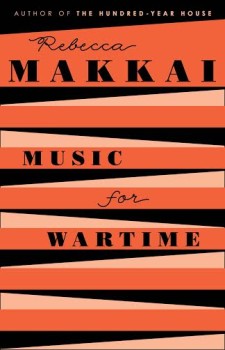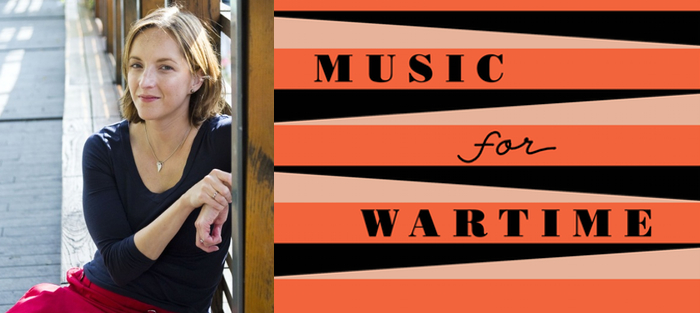Make no mistake: if you’re a writer in Chicago seeking community, StoryStudio Chicago is a great place to start. Founded by Jill Pollack in 2003, this airy, well-appointed, Ravenswood-neighborhood studio is the ideal setting for a writing workshop, whether you’re new to creative writing or working on your second novel. Such was the case for me when I was accepted into Rebecca Makkai’s Novel in a Year workshop: I had just finished with a round of agent queries for my first novel, and had drafted about 150 pages of a second one. I was also starting a new teaching position that fall, and wanted to be sure to keep my fiction writing on track.
I didn’t realize how lucky I was to have chanced upon Rebecca’s workshop. As a debut novelist herself at the time I first met her (if you haven’t read her first novel, The Borrower, it’s a wonderful summer read!), I knew her writerly voice as welcoming, funny, at turns acerbic and inviting, and I was delighted to find that in workshop, it was similar: she quickly established a congenial environment where everyone felt welcome to speak, and times when one writer might have been inappropriately harsh or unfair in comments, she ably turned it into a teaching moment about reading and responding to writing craft.
I felt some relief in the warm immediacy of Rebecca’s welcome; her resume is not unintimidating. She received an MA in English literature from Middlebury College’s Bread Loaf School of English. Her short fiction has been anthologized in The Best American Short Stories 2011, 2010, 2009, and 2008; The Best American Nonrequired Reading 2009; New Stories from the Midwest; and Best American Fantasy; as well as featured on Public Radio International’s Selected Shorts and This American Life. New stories and essays appear regularly in places like Harper’s, Tin House, the Wall Street Journal, and New England Review. She has held fellowships at Yaddo, Ragdale, and the Sewanee and Wesleyan Writers Conferences. In 2014, she received an NEA literature fellowship in fiction. This coming fall, with both her second novel, The Hundred-Year House (Viking, July 2014), and her first short story collection, Music for Wartime (Viking, June 2015) under her belt, she will be a visiting professor at the Iowa Writer’s Workshop.
Despite Rebecca’s literary laurels, I was delighted to find that her craft talks at each workshop were grounded both in providing examples of different aspects of craft along with her own practical experience. And following my time working with her, I was equally delighted to have the opportunity to read—and subsequently talk with her about—her forthcoming collection, Music for Wartime. Rebecca’s writing is at turns muscular and supple: her prose gets the job done in terms of advancing story and developing character, while her deft descriptions of image and setting settle you into her characters’ skins. But one of my favorite aspects of Rebecca’s writing is the puns and other word play, which are hilarious, poignant, and leave you with a prismatic reflection on human experience, one example of which you will find in the middle of our conversation here. We discussed Music for Wartime via email over the course of a few weeks in April as Chicago thawed and the flowers came to bloom.
Interview:
Jennifer Solheim: Let’s begin with a question I hinted at in the introduction to this interview: how to do you feel teaching has influenced your writing?
Rebecca Makkai: I actually taught elementary school for eleven years before I was able to earn a living from writing, and I learned a lot of human psychology in that time—but also, I do believe I internalized this need to make sure that everyone feels okay, that there’s something for everyone to latch onto. (Teaching that level also taught me the urgency of keeping the reader’s attention… If I was reading Charlotte’s Web aloud to them and didn’t make my voice interesting enough, didn’t engage them enough, they’d do stuff like turn around and cut each other’s hair.)
I’ve noticed that, too—reading to children can teach us a lot about the craft of storytelling for us grown-ups. So, how do you channel that (perhaps childlike) demand for urgency in keeping the reader’s attention into your own writing?
 It largely comes through in the way I end a section, how much I leave hanging. You don’t want to manipulate the reader—you don’t want clunky cliffhangers everywhere—but you want to leave enough balls in the air at any time that there’s always something to keep reading for.
It largely comes through in the way I end a section, how much I leave hanging. You don’t want to manipulate the reader—you don’t want clunky cliffhangers everywhere—but you want to leave enough balls in the air at any time that there’s always something to keep reading for.
Over what period of time were the stories in Music for Wartime written?
Thank you so much for asking this. Since it’s coming out only a year after my last novel, I’m getting this reaction all the time of “Oh, you work so fast!” When in fact the oldest story in the book was written in 2002. I think if you charted it out, they’ve been coming pretty steadily since then—with the oldest being heavily revised in recent years, of course. So it’s been a thirteen-year project. It feels about right.
And so, when you looked at old stories and considered your current style and themes of the collection, how did the writing and revision process work? Did you produce anything entirely new for the collection, or was it a matter of revising extant stories?
Let me put this another way: your first novel, The Borrower, is in part a roadtrip story. And your second novel, The Hundred-Year House, is a romp backwards in time at an artist’s retreat. So, with the thematic focus on memory, grief, and loss, the pervasive sadness in Music for Wartime surprised me. In what ways did you consider tone as the collection took shape?
I did produce new things. The three family “legends” are ones I wrote specifically for the book, and the final story, “The Museum of the Dearly Departed,” was my way of wrapping up the book’s themes. It also plays with some of the family history you’d have learned if you read the book straight through, so it speaks back to earlier parts of the collection.
I think those themes you mention are all themes of my novels, too, even if they’re a bit lighter on the whole. (But are they, really? One’s about a kidnapping, and the other has a huge body count by the end.) I’ve discovered that when I try to write funny it comes out very sad, and when I try to write sad it comes out funny. Maybe that’s my core aesthetic, funny-sad. I mean, despite the loss and gloom I do have stories about reality TV, and a woman who coughs up J. S. Bach, and a dead circus elephant. (And I realize as I type this that dead circus elephants aren’t exactly cheerful. But maybe they’re a little bit funny.)
That’s a great way of putting it, funny-sad! Because it’s certainly not “light,” per se—maybe it’s an example of lightness, in the Milan Kundera sense of the term.
So as you revise your work, how do you approach the calibration between funny and sad? How might you heighten the humor in a story with weighty themes, for instance? (I’m thinking here about the word play with “gas” and “guess” in the final story, which really blew my mind—it develops in a subtle way throughout the story and then all of a sudden emerges in the dialogue).
We should explain here (a good example of funny-sad) that the gas of the gas/guess confusion refers both to a gas leak that’s killed several people in modern-day Chicago and to the gas chambers of the holocaust. (Hilarious, right?)
I believe that if you’re looking closely at the world, it’s funny. Even the horrible things are funny in some way. And if you’re looking closely enough, everything’s also pretty sad. So I see it as my job not to shy away from either of those, and to let them coexist. If I’m consciously setting about to make something funnier, I think a lot about syntax. The later in the sentence that the joke can arrive, the funnier. Some sounds are funnier than others. Pacing helps.
There are also several “legends” in the collection—“Other Brands of Poison,” “Acolyte,” and “A Bird in the House”—that are inspired by your family’s history in Hungary and exodus to the United States during Nazi occupation. How did the family stories take shape as fiction? Did anything in that particular writing process surprise you?
Basically, I have to (at least for now) write these as fiction, because it’s very difficult to find the facts of what happened to my family. You’ve phrased it very carefully, which I appreciate, but lest anyone think this was a story of persecuted Jews, no—it’s the opposite. My grandfather made some pretty horrible decisions. My grandmother made some very good ones. But I’m never sure if what I’m hearing about either of them is the truth, and that’s why, for now, I had to write their stories as what I consider “acknowledged fiction”—in other words, I’m there in the story saying, “I don’t know what happened, but this is how I imagine it.” When my children are a little older and I’m freer to travel to Hungary (and if I ever get the grant money to do it), I plan to write an entire book about my grandparents. Nonfiction, or as close as I can get to it.
It seems like another example of acknowledged fiction in Music for Wartime might be “Suspension: April 20, 1984,” in which you describe a photograph from your sixth birthday party and create a narrative of your grandfather through dates relative to that photo, which ultimately spans half a century in time. The use of a photo to blow open a story reminds me of both Georges Perec and Roberto Bolaño—so, was the photograph a kind of writing constraint?
 Yes, and I have to acknowledge that the photograph isn’t real. This is actually the oldest story in the collection, and it came from a graduate course I was taking with the writer David Huddle. He had us vote each week on prompts—just one word each time, like “cooking” or “transformation”—and we’d voted on photo.
Yes, and I have to acknowledge that the photograph isn’t real. This is actually the oldest story in the collection, and it came from a graduate course I was taking with the writer David Huddle. He had us vote each week on prompts—just one word each time, like “cooking” or “transformation”—and we’d voted on photo.
Is “Suspension” an example of a story revised with this collection in mind?
Yes, absolutely. I needed to think about what information was revealed about my family in the earlier stories, and repeat just enough of it that this piece could stand on its own, but not so much that there were redundancies. I also wanted to think about how it would resonate with other stories in the collection, to make sure there were echoes there. I worked on that throughout, finding the objects that might repeat from story to story, or the words that might take on different resonances in different narratives. I don’t believe a collection should just be, literally, a collection of all the stories you’ve already finished. You have to think about it as a book, a whole. (I had the voice of Project Runway’s Tim Gunn in my head occasionally, telling me my collection had to cohere. Oddly helpful.)
Where did family history end and fiction begin with “Suspension”?
Aside from the fact that there’s no photograph, the historical facts are all correct. My grandfather wouldn’t have been at my 6th birthday, and since my sister is actually ten years older than me, there’s very little chance she’d have been jumping on a trampoline that day. And no one ever gave me a plastic bomb. And the idea of a “steep hill” in Chicago is kind of ridiculous. But the history—what my grandfather did in the 1930s, both good and bad—that’s all true.
Are there any short story collections that influenced how Music for Wartime took shape? How so?
Hmm. I thought a bit about how Aleksander Hemon messes with us, and with the line between fiction and nonfiction, in The Question of Bruno. And I loved what Jamie Quatro did in I Want to Show You More, interpolating shorter, connected pieces within the whole. But to be honest I read both of those after Music had come together. They were more like confirmation that what I was trying to pull off was tenable.
As the title suggests, music is woven throughout the collection; it begins and ends with the sound of singing. Is music going to play a role in the book launch and party?
Ooh, I hadn’t thought of that. Are you volunteering to play guitar?
Ha! Well… no. I’m a bit rusty. But let me know if you want help with a playlist! You’ve been very busy over the past year with finishing Music For Wartime and promoting The Hundred-Year House—do you have a new project in the works already?
Yes. I’ve been working since the fall on a novel that’s set partly in 1980s Chicago, against the backdrop of the AIDS epidemic, and partly in modern-day Paris. But I do wish I had more time to write. Sometimes I feel like I have less writing time as a “full-time” writer than I had when I taught elementary school.






